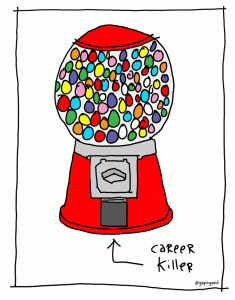 Want your donors to sustain you? Then you can’t consume them in five minutes.
Want your donors to sustain you? Then you can’t consume them in five minutes.
Yet all too often nonprofits treat their donors exactly like a gumball dispensed from a machine. Chew it up. Spit it out. Done.
Oh, yeah… maybe you send a quick thanks to whoever gave you the change to buy the gum. But that’s as far as your gratitude takes you. You’re over it. You never even think about that gumball again. You probably can’t even remember what color it was. You’re off hunting down your next snack.
Little snacks are nice. But they won’t sustain you over time.
One-time donations are the same way. And they’ll stay that way – one time – if you treat them the way you treat your gumballs.
There’s a better way.
You’ve got to think from the perspective of the gumball.
It’s perfectly happy to have you enjoy it. That’s why it’s there. But it wants to know it made an impact.
- Tell it how happy you are with it.
- Tell it you think its color is pretty (that means, of course, that you have to take notice).
- Blow a bubble.
- Tuck it away to save it for later.
- Write it a note.
- Invite some of its friends over to your place.
- Find out more about it.
- Think of it fondly, and let it know now and again.
- Ask it for advice.
- Don’t wait until the next time you want a gumball to tell this one how you feel.
Okay… the metaphor may be breaking down a bit, but you get the picture.
You’ve got to think about building a relationship with your gumball (aka donor).
No one enjoys being simply tossed into the trash (or your donor data base) and then being forgotten about.
If a donor makes a gift and you simply dispense an automated thank you, and nothing more, that’s not a donor relationship. That’s a transaction.
You can have 100 or 1,000 or 100,000 thousand transactions this year. But that’s just now. They may help you balance your annual ledgers, but they won’t move the needle on solving your overarching problem or achieving your ultimate vision.
One-time gifts are here today, gone tomorrow. In fact, a whopping 80%+ of first-time donors won’t give again. Zowie!
Transactions won’t help you next year or the year after that.
No. You’ve got to transform the transactions into something longer lasting.
Stop with the spitting out of snacks. Start with creating some nourishing meals.
Here’s another metaphor – the potluck.
When I’m asked to bring some snacks or paper goods or even a beverage, I run to the store at the last minute and grab something. I’m not too invested. However, when I’m asked to bring a main course that will serve 10, then I get serious. I think about what I’ll make. I go to the store and buy enough ingredients to serve the full group. I come home and cook. I make sure I don’t flake out because people are depending on me for the main meal. Even if I get sick, I’ll make sure somehow the meal gets there. That’s how you want your donors to feel!
Your donor needs to know you rely on them.
You’re all about solving problems, right? Well so is your donor. They need to know they’re essential to your survival.
It’s your job to let them know. If they ask how much you need, don’t say “any gift helps.” That’s like telling me to bring “whatever” to the potluck. It makes me feel unimportant, and certainly doesn’t fire my imagination.
If you’ve been treating your donors like gumballs, start tomorrow to make them feel more important.
5 Tips to Keep Your Donors
1. Thank them immediately, and with gusto.
Savor the moment of this first gift. Remember, first gifts are where the relationship building begins. They aren’t where it ends. A study conducted by Charity Dynamics and NTEN shows that 21% of donors say they were never thanked for their support. Don’t be one of the bad guys.
2. Pay attention to any particularities.
- Did they ask to remain anonymous?
- Do they want you to mail only once a year?
- Did they ask you not to send a written thank you?
- Is there contact information on their check that isn’t yet in your database?
- Did they inform you they’d included you in their will or trust?
You want to reflect these details back to the donor so they know you paid attention. You also want to make a record of whatever you notice — put this into your database! — so you can create reports, queries and donor segments later on (if you don’t notice the gumball is blue you can’t group it in your database with all other blue gumballs, nor can you indicate in your thank you what a lovely blue color they were sporting).
3. Develop and implement a donor stewardship plan.
Create and offer your donor opportunities of value to them. Donors want to know their money didn’t go into a black hole. Many want opportunities to come together with like-minded people.
- Thank donors more than once.
- Show donors the impact of their gift through photos, videos, client thank you letters, etc.
- Make sure you touch donors more than once before you ask for another gift.
4. Wrap engagement opportunities into your stewardship plan.
The goal is to learn more about your donor, and reveal more of yourself to them. This is what’s called a relationship, and it requires an investment of your time. And the donor’s time. Once a donor becomes engaged they’re much more likely to become invested further. That’s why Publisher’s Clearinghouse makes you tear off and affix a zillion stickers to your sweepstakes entry. They want you to have some skin in the game.
- Host virtual Town Halls, speaker events, and Q & A sessions.
- Host behind-the-scenes “show and tell” tours (may be virtual).
- Host open houses on-site.
- Hold intimate porch parties in private homes.
- Hold free donor appreciation events.
- Recruit donors for direct service volunteer opportunities
The wedding comes after the engagement. If you want folks to say “I do”, don’t rush it.
5. Always be donor-centered.
Today’s donors can be found in many different places. Maybe your first gumball came from a machine. But gumballs also hang out in boxes on shelves in stores. And you can find them in piñatas. If you want to consistently find them, you have to look in all the places they are. If you want folks to be there for you, you’ve got to be there for them. It’s just common sense. So find out which social channels your supporters frequent (you can do a simple survey using Google Docs or Survey Monkey); then engage your donors where they are.
Donors are People Too
Don’t you like it when people make an effort to get to know you?
Don’t you appreciate it when they then show you they know you?
True Story: “Just because,” yesterday my next-door neighbor texted me a photo of a dress that showed up in her IG feed that made her think of me. First, her thoughtfullness was so nice, and made me feel good. Second, I had no idea she was paying attention to my style — especially to this extent –because she nailed me!. Here’s the photo she sent:
Advertisement for colorful quilt-pattern dress
Here’s the photo I sent back to her.
Colorful quilted doily sitting on my bedside table (I don’t believe she’s ever seen it)!
Whoa, right?! When you pay attention… try to step inside your donor’s shoes… really get to inhabit their mind, heart, and soul… then you’re able to make the value-for-value exchange that fuels passionate philanthropy.
It’s pretty simple, but for some reason most nonprofits don’t do it all that well. If you become the exception, you’ll rock your fundraising next year.
What’s your favorite donor relationship-building tip?
Want to Connect More Meaningfully with Donors?
 Grab the Donor Retention and Gratitude Playbook. You’ll get six companion guides filled with everything you need to make a great first impression — and then a terrific second, third and fourth impression — by thanking, praising and engaging with your donors in a manner that makes them want to stay loyal to you. And if you can increase retention by just 10%, you can double the lifetime value of your current supporters. So it’s well worth the effort and investment.
Grab the Donor Retention and Gratitude Playbook. You’ll get six companion guides filled with everything you need to make a great first impression — and then a terrific second, third and fourth impression — by thanking, praising and engaging with your donors in a manner that makes them want to stay loyal to you. And if you can increase retention by just 10%, you can double the lifetime value of your current supporters. So it’s well worth the effort and investment.
All Clairification guides come with a 30-day, no-questions-asked, 100% refund guarantee. You can’t lose – so why not go for it? Send your donors all the love and flowers you can dream up. Imagine what a hero you’ll be when you totally make your donor’s day, and dramatically increase your nonprofit’s revenue moving forward?
Questions? Email me at claire@clairification.com.
Image: Three San Francisco Hearts: Love Sent. Received, Shared; Together Under the Stars; Justice. Benefit for S.F. General Hospital Foundation. Cartoon by Hugh MacLeod, Gaping Void








